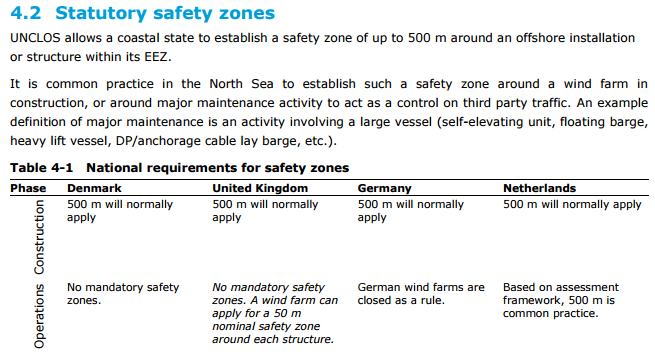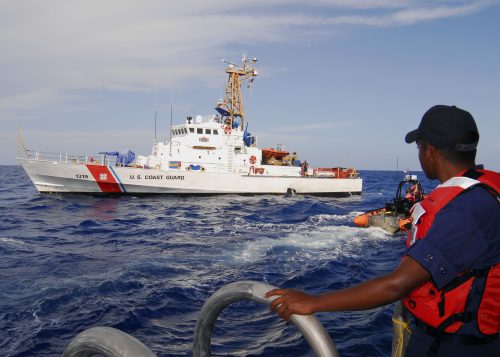According to information obtained from a source involved in the Coast Guard study on integrating a proposed offshore wind energy industry and shipping off the Eastern Seaboard, and research conducted by Checks and Balances Project, no one from the Coast Guard had any meaningful engagement during the course of the study with individuals, companies or organizations from Europe’s thriving offshore wind energy industry.
In fact, according the source, who asked not to be named, the only visit was with Trinity House, a British Royal charity dedicated to safeguarding shipping and seafarers, a visit referenced in neither the study’s Interim Report nor its Final Report.
The Coast Guard was tasked with studying how to balance developing offshore wind for the U.S. – a stated presidential priority – with shipping lane safety. Five years later, the working group declared the pollution-free offshore wind could actually hurt American energy independence, directly undercutting the President Obama’s aspirations.
Old Data Limits Space
Instead of traveling to Europe or asking for a liaison from its booming offshore wind energy industry to brief the study’s Working Group, outdated international data was used to create guidelines for setback distances between offshore turbines.
The data was from the United Kingdom’s Offshore Renewable Energy Installations (OREIs) – Guidance on UK Navigation Practice, Safety and Emergency Response Issues – published in 2008 — four years before the Coast Guard’s Atlantic Coast Port Access Route Study (ACPARS) Interim Report was published and eight years before the Final Report was released in March 2016.
The Coast Guard’s Final Report ignores the UK’s new guidance document released in February 2016, which is a major mistake, according to a comment letter submitted by the New York Department of State. The “information should be updated to reflect the current state of knowledge.”
The American Wind Energy Association echoes this point. Its letter notes, “One key difference between the new guidance and the one it replaced is its elimination of the recommended distance (5 NM) between a wind project and a TSS entry/exit, the same distance ACPARS proposes.”
The Coast Guard produced a sloppy, five-year study that is hindering the creation of an offshore wind industry in the U.S. because the recommended setbacks dramatically limit space for wind energy installations on the Atlantic Coast and remove blocks from currently leased areas.
In New York state alone, the Coast Guard’s recommendations would remove more than half of the 81,000 acres that have designated safe for offshore wind development.
Europe’s Head Start
Europe’s offshore wind industry has a huge head start on America, despite having some of the busiest shipping traffic in the world. Not only does the North Sea see more than 260,000 shipping movements annually, it also has two of the largest wind farms in the world.
Belying the Coast Guard’s unbalanced focus on shipping safety, University of Delaware’s Special Initiative on Offshore Wind notes, “In Europe, the density of offshore wind farms is considerable, yet the maritime industry has accommodated the growth safely and with minimal economic impact – and absolutely without the need for navigation safety corridors.”
This is echoed by a recent report released by the Danish Maritime Authority in December 2015. You can see an excerpt from that report below and read the entire study here.
Figure 1. Excerpt from Danish Maritime Authority’s “Summary report on North Sea regulation and standards”

In total, the North Sea has more than 25 operating wind farms, with ongoing plans to build a total of 10,000 wind turbines. Additional information from the European Wind Energy Association (EWEA) notes:
- 3,230 turbines are now installed and grid-connected, making a cumulative total of 11,027 MW.
- Including sites under construction, there are 84 offshore wind farms in 11 European countries.
- 3,019 MW of net installed, grid-connected capacity was added in 2015, 108% more than in 2014.
- A net addition of 754 new offshore wind turbines in 15 wind farms were grid-connected from 1 January to 31 December 2015.
- 419 new turbines were erected in 2015. Seven turbines were decommissioned in the UK and Sweden, resulting in a net addition of 412 turbines.
BOEM’s Concern
In a significant comment letter, Bureau of Ocean Energy Management (BOEM) Director Abigail Ross Harper expresses concerns about the guidelines and setbacks proposed by the Coast Guard, and their potential negative effects on the leasing and planning phase.
According to the letter, rather than the Coast Guard’s one-size-fits-all approach, which would remove large areas from current and potentially leased wind energy areas, BOEM “strongly believes that site-specific development of setback distances that consider the unique characteristics of each project/area is the most appropriate method for establishing the necessary buffers.”
Read BOEM’s letter here. Read other comments about the ACPARS study here.
Because of flawed data, a lack of interest in investigating Europe’s successful integration of the shipping and wind industries, and a secret and obscure process, the Coast Guard cannot reasonably justify using the ACPARS recommendations to determine siting offshore wind projects.
As the questions about the study grow, and the Coast Guard continues refusing to answer our basic questions about the Working Group, will the Coast Guard continue to push recommendations that are hindering the growth of an American wind industry and have been discredited by private companies, trade associations, federal and state agencies and international success?
Read More
Coast Guard Still Won’t Provide Basic Information About Offshore Wind Energy Study
Coast Guard Study Blockades Offshore Wind Energy
Evlondo Cooper is a senior fellow with Checks and Balances Project, a national watchdog blog that seeks to hold government officials, lobbyists, and corporate management accountable to the public. Funding for C&BP comes from pro-clean energy philanthropies and donors.







Recent Comments